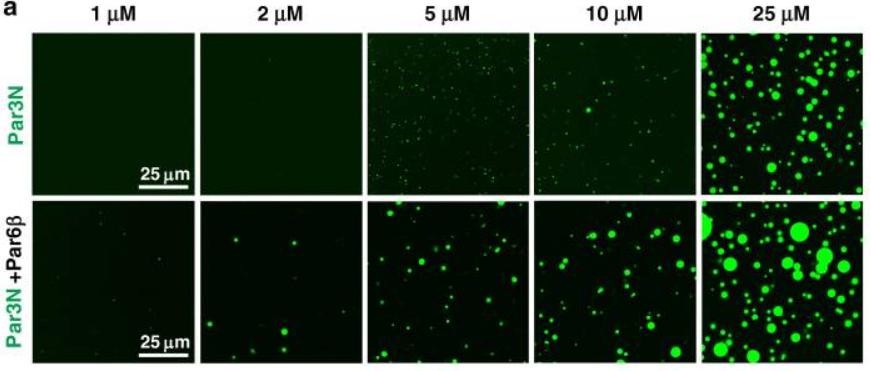Basic information
LLPS related evidences
| Publication note | Here we show that the Par complex exhibits cell cycle-dependent condensation in Drosophila neuroblasts, driven by liquid-liquid phase separation. The open conformation of Par3 undergoes autonomous phase separation likely due to its NTD-mediated oligomerization. Par6, via C-terminal tail binding to Par3 PDZ3, can be enriched to Par3 condensates and in return dramatically promote Par3 phase separation. aPKC can also be concentrated to the Par3N/Par6 condensates as a client. Interestingly, activated aPKC can disperse the Par3/Par6 condensates via phosphorylation of Par3. Perturbations of Par3/Par6 phase separation impair the establishment of apical-basal polarity during neuroblast asymmetric divisions and lead to defective lineage development. (Organism: Rattus norvegicus; Cell line: COS-7 cells) |
||
|---|---|---|---|
| Material state | liquid,hydrogel : FRAP analysis revealed that both Par3N and Par6β in the condensed puncta rapidly exchanged with the proteins in the surrounding cytoplasm. Those Par3N/Par6β droplets transitioned into gel-like structures over time, and the droplets rarely fused together after 20 min. | ||
| LLPS region | 1-1337,1-685,1–854 | Key domains | N-terminal domain (NTD),PDZ3 : Removing NTD (ΔNTD) from Par3N significantly reduced phase separation efficiency of the Par3N/Par6β complex, as well as that of Par3N alone. deletion of PDZ3 (ΔPDZ3) but not PDZ1 (ΔPDZ1) from Par3N effectively impaired LLPS of the Par3N/Par6β complex. |
LLPS partner
| Protein partner | Par6,aPKC ( Q9JK83,Q62074 ) |
Par6, via C-terminal tail binding to Par3 PDZ3, can be enriched to Par3 condensates and in return dramatically promote Par3 phase separation. aPKC can also be concentrated to the Par3N/Par6 condensates as a client. |
|---|---|---|
| RNA partner | _ |
_ |
| Others | _ |
_ |
LLPS regulation
| PTM | phosphorylation |
Activated aPKC can disperse the Par3/Par6 condensates via phosphorylation of Par3. |
|---|---|---|
| Mutation | p.V13D,p.D70K,p.S827E,p.S829E |
When introducing a V13D, D70K mutation in Par3 NTD (referred to as NTDmu), which disrupts its oligomerization, only very few puncta could be detected. Fewer puncta were observed when Par6β was co-expressed with Par3 Δ4N12 S827,829E when compared with Par3 Δ4N12. |
| Alternative splicing | _ | |
| Repeat | _ | |
| Oligomerization | Removing NTD (ΔNTD) from Par3N significantly reduced phase separation efficiency of the Par3N/Par6β complex, as well as that of Par3N alone. | |
